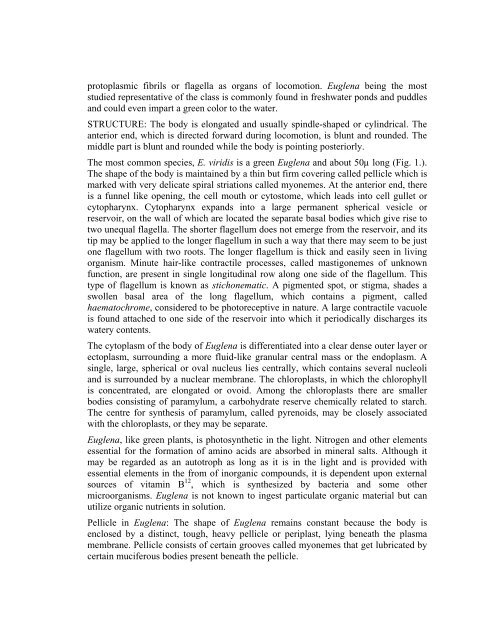ANIMAL DIVERSITY – I (NON-CHORDATES)
ANIMAL DIVERSITY – I (NON-CHORDATES)
ANIMAL DIVERSITY – I (NON-CHORDATES)
You also want an ePaper? Increase the reach of your titles
YUMPU automatically turns print PDFs into web optimized ePapers that Google loves.
protoplasmic fibrils or flagella as organs of locomotion. Euglena being the most<br />
studied representative of the class is commonly found in freshwater ponds and puddles<br />
and could even impart a green color to the water.<br />
STRUCTURE: The body is elongated and usually spindle-shaped or cylindrical. The<br />
anterior end, which is directed forward during locomotion, is blunt and rounded. The<br />
middle part is blunt and rounded while the body is pointing posteriorly.<br />
The most common species, E. viridis is a green Euglena and about 50µ long (Fig. 1.).<br />
The shape of the body is maintained by a thin but firm covering called pellicle which is<br />
marked with very delicate spiral striations called myonemes. At the anterior end, there<br />
is a funnel like opening, the cell mouth or cytostome, which leads into cell gullet or<br />
cytopharynx. Cytopharynx expands into a large permanent spherical vesicle or<br />
reservoir, on the wall of which are located the separate basal bodies which give rise to<br />
two unequal flagella. The shorter flagellum does not emerge from the reservoir, and its<br />
tip may be applied to the longer flagellum in such a way that there may seem to be just<br />
one flagellum with two roots. The longer flagellum is thick and easily seen in living<br />
organism. Minute hair-like contractile processes, called mastigonemes of unknown<br />
function, are present in single longitudinal row along one side of the flagellum. This<br />
type of flagellum is known as stichonematic. A pigmented spot, or stigma, shades a<br />
swollen basal area of the long flagellum, which contains a pigment, called<br />
haematochrome, considered to be photoreceptive in nature. A large contractile vacuole<br />
is found attached to one side of the reservoir into which it periodically discharges its<br />
watery contents.<br />
The cytoplasm of the body of Euglena is differentiated into a clear dense outer layer or<br />
ectoplasm, surrounding a more fluid-like granular central mass or the endoplasm. A<br />
single, large, spherical or oval nucleus lies centrally, which contains several nucleoli<br />
and is surrounded by a nuclear membrane. The chloroplasts, in which the chlorophyll<br />
is concentrated, are elongated or ovoid. Among the chloroplasts there are smaller<br />
bodies consisting of paramylum, a carbohydrate reserve chemically related to starch.<br />
The centre for synthesis of paramylum, called pyrenoids, may be closely associated<br />
with the chloroplasts, or they may be separate.<br />
Euglena, like green plants, is photosynthetic in the light. Nitrogen and other elements<br />
essential for the formation of amino acids are absorbed in mineral salts. Although it<br />
may be regarded as an autotroph as long as it is in the light and is provided with<br />
essential elements in the from of inorganic compounds, it is dependent upon external<br />
sources of vitamin B 12 , which is synthesized by bacteria and some other<br />
microorganisms. Euglena is not known to ingest particulate organic material but can<br />
utilize organic nutrients in solution.<br />
Pellicle in Euglena: The shape of Euglena remains constant because the body is<br />
enclosed by a distinct, tough, heavy pellicle or periplast, lying beneath the plasma<br />
membrane. Pellicle consists of certain grooves called myonemes that get lubricated by<br />
certain muciferous bodies present beneath the pellicle.
















